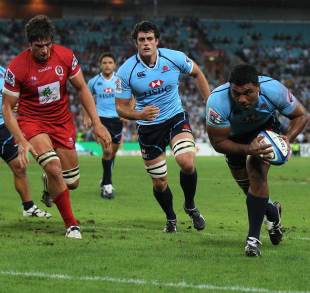|
Super Rugby
Waratahs using technology to predict player injuries
Andy Withers
November 27, 2013

Wycliff Palu "used to think injuries were a bit of bad luck"
© Getty Images
Enlarge
New South Wales Waratahs are using predictive analytics programs to reduce player injuries as they seek to win their maiden Super Rugby title in 2014. The Waratahs are using the technology to inform decisions regarding player training load, enabling the training and coaching staff to "predict and act rather than sense and react" in order to field the best possible team throughout the season. The analysis predicts the likelihood of a particular player being injured, which then enables the coaching team to adapt and modify each player's personalised training program to maximise their training load and minimise their risk of injury. Statistics currently show that rugby players miss an average 2.15 games per season, and Waratahs athletic development manager Haydn Masters said in describing his ultimate goal that "0 is a great number, isn't it". More realistically, Masters hopes the technology will enable the Waratahs to enjoy "95% player availability" through a season.
Wycliff Palu's Injuries since 2011
"The aim of our strength and conditioning program is to improve athletic performance and increase injury resilience to ensure players spend the most amount of time possible on the field," Masters said. "IBM's predictive analytics technology gives us a very objective, sensitive and reliable measure of predicting each player's limit and their injury risk and allowing us to modify training accordingly." The Waratahs collect player data from a range of sources including a GPS tracker fitted to each player to measure and monitor intensity levels, collisions, and fatigue during training and matches. The data is then combined with medical data, wellness data and player data; over a period of time, clear patterns and early warning signs start to emerge. "At the moment we collect between 100 and 250 variables per player per week from GPS data, medical screenings and wellness reports. IBM's system allows us to collate and analyse all these variables, which in turn helps us to best manage each player and, over time, build an accurate picture of what to look for individual players [and future players] and positions, in terms of predicting injury risk." The Waratahs looked to adopt the technology after being shown a presentation that predicted "100% accurately" injuries to Wycliff Palu, Drew Mitchell and Lachlan Turner. Masters accepted the technology did not predict specifically the trio's respective "hard-tissue" knee injury, rolled ankle and fractured lower leg, but he said the data patterns indicated the players were not at their peak and were then more susceptible to fatigue that could lead injury because they could not "get out of the way of danger".
Masters said the key to keeping players on the pitch was found in continuous training to develop "injury resilience" and thereafter to improve athletic performance because the coaching staff could identify exactly what was safe and how hard to push. "Sports science is here to make the art of coaching easier," Masters said, noting that the technology allowed him to identify a player's "athletic movement signature" that is "as individual as a fingerprint". Masters said "we're not going to pull a player out of a game, but put in place a level of change to reduce injury risk". Palu has spent a substantial amount of time sidelined by injuries in recent seasons, and he is happy to see the Waratahs using anything that can keep him on the pitch. "I would have liked it if it had come a couple of years earlier," Palu said of the technology. "I used to think injuries were a bit of bad luck … " 
Infographic publlished courtesy of New South Wales Waratahs © New South Wales Waratahs
Enlarge
© ESPN Sports Media Ltd Andy Withers is the Editor of ESPNscrum Australia and New Zealand. Join the conversation with Andy on Twitter @witho68
| |||||||||||||||
Live Sports
Communication error please reload the page.
-
Football
-
Cricket
-
Rugby
-
- Days
- Hrs
- Mins
- Secs
F1 - Abu Dhabi GP
Abu Dhabi Grand Prix December 11-131. Max Verstappen ()
2. Valtteri Bottas (Mercedes)
3. Lewis Hamilton (Mercedes)
4. Alexander Albon ()
5. Lando Norris ()
6. Carlos Sainz Jr ()
-
ESPNOtherLive >>
Boxing - Nelson v Wilson; Simmons v Dickinson; Joshua v Gavern (Metro Radio Arena, Newcastle)
Golf - Houston Open
Snooker - China Open
Tennis - Miami Open

